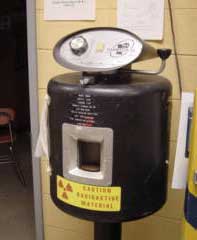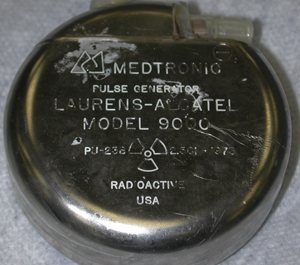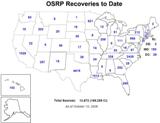|
Google Site Search:
|
Frequently Asked Questions (FAQs)How do I register my unused sealed sources?Unwanted sealed sources may be registered with OSRP in a number of simple ways. In order to enter your sources into our information database we will need specific info about the facility or site (e.g., location, licensing authority, etc.), contact information (e.g., name, address, phone number, email, etc.), and specific data about each individual unwanted source (e.g., manufacturer, model, serial number, isotope, activity, etc.). Registration methods include:
In some cases legal reuse and recycling might be possible and is encouraged by NNSA and OSRP. By completing source registration with OSRP, registrants indicate that they have considered recycling but have chosen not to pursue that action. Registration does not imply nor guarantee that the program can assist with removal/disposition of all radioactive material. OSRP is not affiliated with a National Source Tracking system but we encourage licensees to register all unwanted sealed sources, regardless of activity. OSRP will consider recovery on a case-by-case basis, or may attempt to assist by coordinating other removal mechanisms. What sources are recovered by the OSRP?Prior to November 2000, OSRP focus was environmental clean-up limited to recovering US-origin radioactive sealed sources that had no commercial disposal path in the U.S. Such sources were generally classified as Greater Than Class C (GTCC) Low Level Radioactive Waste as defined in 10 CFR 61.55. In practice, this meant recovery of sealed sources containing US-origin transuranic isotopes such as Am-241, Pu-238, and Pu-239 with activities greater than 0.5 mCi. These transuranic isotopes were often combined with light elements such as beryllium or lithium to generate neutrons (i.e., Am-241/Be, Pu-238/Be, Pu-239/Be, Am-241/Li and Pu-238/Li). OSRP has also collected Am-241/Be/Cs-137 and Pu-238/Li/Cs-137 combination sources, as well as a few sources containing Cm-244 and Cf-252. In November of 2003, the NNSA assumed responsibility for OSRP and the focus of the mission became removal of excess sources that posed a potential threat to public health, safety, and national security. NNSA immediately increased the scope of OSRP work to include the isotopes of concern to the International Atomic Energy Agency (IAEA). These additional isotopes are Cs-137, Sr-90, Ir-192, Co-60, and Ra-226 that do not have a commercial disposal outlet. Since 2003, OSRP has continued recovery of US-origin actinide/transuranic sources, but has also established the ability to recover and manage these additional non-actinide isotopes that are not commercially disposable. So far, priority has been to concentrate on recovery of very large (over 200 Ci) Cs-137, Co-60 and Sr-90 sources. However, where excess and unwanted sources of lower activity are found at a particular location, consideration is given to the sum total of activity from a security perspective. Licensees holding excess and unwanted sources of any isotope or activity level should check with the OSRP if problems with disposition occur.* If OSRP cannot recover the sources directly, the staff can often point out other options that may be helpful. *All unwanted sealed sources should be registered, regardless of activity. OSRP will consider recovery on a case-by-case basis, or may attempt to assist by coordinating other recovery mechanisms. However, registration does not imply nor guarantee that the program can assist with removal/disposition of all radioactive material.
What if my high-activity device is still being used?In the United States, NNSA’s Global Material Security Program (formerly GTRI) is also able to enhance the protection of nuclear and radiological materials at civilian sites through voluntary security enhancement efforts. These voluntary security enhancements complement but do not replace Nuclear Regulatory Commission (NRC) and Agreement State increased control requirements. They are federally-funded, sound, cost-effective, and prudent best practices that further improve security above regulatory requirements. If you would like more information about how the NNSA voluntary Radiological Security Partnership program can help you enhance and strengthen your radiological security plan, please visit -- https://nnsa.energy.gov/RSP.
Is there a way for the radioactive sealed sources to be reused/recycled?In some cases legal reuse and recycling might be possible and is encouraged by NNSA and OSRP. This can be done by a licensee-to-licensee transfer in compliance with applicable regulations. OSRP is not involved in the recycling process nor non-recovery-related shipments of materials between licensees. If interested in possibly finding continued use for your unwanted radioactive material, check with the manufacturer or other interested parties on the CRCPD List of Possible Outlets for Common Radioactive Materials and contact them directly for more information. For high-activity sources, please see the CRCPD List of Recyclers of High Activity Sources and contact them directly for more information.
What if my unwanted source is still in a device?Since OSRP is not authorized by DOE to perform disassembly services, the source would normally* have to be removed from the device or housing before it could be considered for possible recovery. Few licensees are authorized by their regulator (NRC or Agreement State) to perform activities such as disassembly, source removal, and handling of bare sources. Therefore if the unwanted sources are still in a device, the options below should be considered:
*Please note: Removal of source(s) from the device is not necessarily required for high-activity sources such as irradiators or teletherapy devices. Such handling should only be performed by qualified personnel. Removal of high-activity items are handled by OSRP and their subcontractors on a case-by-case basis. In most instances, the entire device is removed intact due to the inherent shielding it provides for the sources. Furthermore, sources should not be removed from smoke detectors.
What can I do with License Exempt Sources?Sealed sources with activities equal to or less than the values set by 10 CFR 30.71 Schedule B do not require an NRC license or agreement state equivalent. These sources have a commercial disposal pathway. The license exempt limits can be found at this eCFR link (Schedule B). Agreement States may have their own list of exempt sources within their jurisdiction. Facilities should use commercial waste broker services for arrangements -- https://www.crcpd.org/resource/resmgr/docs/Commercial_Services/RadWasteBrokerServices.pdf.
What can I do with unwanted uranium items or material?Licensee with unwanted uranium (other than depleted uranium, DU), may address inquiries for assistance to the Central Scrap Management Office for Uranium (U-CSMO). In the case when the private sector has DOE owned uranium for some reason, or a person has uranium that they should not have (e.g., in someone’s garage), then the CSMO could still be contacted to engage the right resources. The Y-12 CSMO in Oak Ridge, TN is the only remaining CSMO, and the U-CSMO does not accept or arrange for return of spent nuclear fuel or irradiated uranium. For more information refer to -- https://www.y12.doe.gov/mission/global-security/nuclear-material-recovery/central-scrap-management-office.
What is SCATR?The Conference of Radiation Control Program Directors (CRCPD) and DOE/NNSA have created a program entitled Source Collection and Threat Reduction (or SCATR) to collect sources being stored and not used that could - as an aggregate - be used for malicious intent. DOE recognizes that the availability of disposal of such sources is limited and expensive; and has initiated this rare opportunity for licensees to have financial assistance in properly securing and disposing of these sources through this CRCPD program. The SCATR program is limited to sources that do not meet International Atomic Energy Agency’s Category 1 and 2 sources. Examples of sources that would be eligible for the SCATR program include medical brachytherapy sources (137Cs and 226Ra), eye applicators, low activity sources that exceed the NRC 120-day half-life limit for decay-in-storage, long half-life industrial sources and calibration sources. This program is limited to sealed sources, and does not include non-commercially disposable transuranic isotopes (these can be recovered directly by OSRP). In addition, sources that have already passed through ten half-lives should not be registered for SCATR. For more information please visit CRCPD website at https://crcpdpro.wpenginepowered.com/scatr/ or contact Mr. Michael Snee at 502-545-6679 (msnee@crcpd.org). For assistance with the source registration process, please contact OSRP.
Are sealed sources and special form sources the same thing?No, sealed sources and special form sources are not necessarily the same thing. However, they are related to each other. According to The U.S. Nuclear Regulatory Commission (NRC), "sealed source" simply means that radioactive material is encased in a capsule designed to prevent leakage or escape of the material. In addition to meeting the definition of a sealed source, "special form" sources must satisfy the following DOT conditions according to 49 CFR 173.403:
Therefore, special form sources are simply items that have been tested and the “special form” character of the containment is certified; all other materials are considered "normal form" even if they are in a capsule. For example, an IAEA Certificate of Competent Authority issued by the cognizant agency in a country is a special form certificate showing that the sources listed on the certificate have been designed to meet specific durability testing requirements and are unlikely to release their radioactive contents even under extreme conditions. According to 49 CFR 173.476, in order to transport a radioactive material as 'special form,' the shipper is required to have on file: a current copy of the IAEA Special Form Certificate; or a complete safety analysis, including documentation of any tests, demonstrating that the item(s) meets the requirements of § 173.469. Possible sources of Special Form Certificates include: manufacturers, distributors, service companies, waste brokers, regulatory authorities, and the RAMPAC Database.
Are there different types/categories of sealed sources?Many different types of sealed sources have been manufactured containing radioisotopes that range in activity from microcuries to thousands of Curies. Much of what OSRP has recovered to date contain transuranic material, such as Pu-239, Pu-238, and Am-241 sealed sources, as well as some other actinide isotopes. Some of these sources also contained light metal such as beryllium or lithium to enhance neutron generation. Irradiation devices, such as Gammators, contain gamma-ray emitting isotopes such as Cs-137 or Co-60. Sr-90 has been used to make radioisotope thermoelectric generators (RTGs) where the energy of the beta particle emission is captured as heat, some of which is converted to electricity using thermocouples.
What are, or were, sealed sources used for? Sealed sources are still used in a wide variety of applications. Many are used for research purposes in educational institutions, in medical
applications, and in gauging devices (e.g., thickness, level, density, or moisture gauges). Pu-238 was used in cardiac pacemakers and
Am-241 is commonly present in smoke detectors
For more examples of sealed sources, visit the IAEA Sealed Source Toolkit.
What information will OSRP request from those registering sources?Once sources have been registered with OSRP and reviewed, an email confirmation will be sent along with an information sheet
How can I see what has been registered for my facility; or how do I change the inventory?Once sources are registered, those data entries can no longer be viewed by the registrant. Access to the information system is limited for security purposes. Registrants can request status updates, at any time, by contacting OSRP by phone, fax, or email. Similarly, changes to source registrations including addition/removal of sources and updates to site contact information can be submitted via phone, fax, or email. Routine information verification may be requested from each site once per year, via phone or email. Note: The OSRP verification process is not affiliated with the NRC National Source Tracking System annual reconciliation process.
We have several sources that are still in use by authorized users. Should these be registered?Unwanted sources are known as “excess sources” in our database; however, sources that are still in use may also be registered at any time by simply indicating that they are not excess. These non-excess (still in use) sources will appear in our database, but will not be considered for recovery until we are informed by the owner that they are no longer wanted. Sources can be changed from "still in use" to "excess," or vice versa, by contacting OSRP by phone, fax, or email and specifying the requested change.
What is the status of OSRP recovery efforts?In total since 1997, OSRP has been able to recover over 47,600 sources from more than 1750 sites (including all 50 states, D.C., Puerto Rico and 29 foreign countries). These recoveries have resulted in more than 1.58 million Curies of radioactive material being removed and secured. See our U.S. recoveries to date
Why do sealed sources need to be recovered?Some sealed source owners or custodians are no longer licensed by the NRC or Agreement States and/or can no longer properly maintain security of sealed sources in their possession. Other sealed sources are beyond their certified life and/or have no disposal option. Sealed source owners have been forced to store these unwanted sealed sources, in some cases for many years. Recovery of these excess and unwanted radioactive sources is necessary because such entities do not typically have the kind of organized and secure storage necessary to prevent unauthorized access to the radioactive material.
How long has OSRP and LANL been recovering sealed sources?LANL began accepting Pu-239/Be neutron sources in 1979 and had been chemically separating Pu-239 material from sealed sources at a Laboratory facility. They had processed about 1100 by 1998, when DOE ended this practice for programmatic reasons. In about January 1999, the DOE management strategy changed to "aggressive source recovery with consolidation of sources in multifunction shielded containers for storage until disposal is made available." OSRP was created to implement the new strategy and has been actively recovering and disposing of unwanted sealed sources from off-site locations as far back as 1997.
Who tasked OSRP and LANL with sealed source recovery?DOE's Office of Environmental Management initially created the Off-Site Source Recovery Project at LANL and tasked it with recovery and management of all unwanted sealed sources until a disposal pathway could be developed. In October 2003, responsibility for OSRP moved to the National Nuclear Security Administration (NNSA) Office of Global Threat Reduction with a national security mission to recover, secure, and safely dispose of unwanted and excess sealed sources. In 2014, the Office of Global Threat Reduction was transitioned into a program with the NNSA Office of Global Material Security. Can you provide input for my EOD master board scenario?Generally speaking our program might be able to provide technical assistance with your scenario, but would not visit the site nor receive the source(s) for disposal. OSRP also does not keep track of entities that may be able to assist with receipt, storage, or disposition of orphan sources around the world. The International Atomic Energy Agency may be a possible resource for initiating such assistance. For most EOD scenarios, the general recommendation would be to check for contamination on and around the source and confirm/identify the material contained within. Take photos and gather any relevant documentation from the source location that might provide source information. Then if the situation warrants it, secure the source in a container with adequate shielding, and return it to the rightful owner, or manufacturer, or transport to a secure US base of operation that has a radioactive materials license and radiation safety program able to handle/store that type of material. If needed, those commands should be contacting their RPM at RASO for guidance. If there is no identifying paperwork or there are no source markings or other identifying features on the device or source holder, and gamma spectroscopy is inconclusive, then you could call upon OSRP technical expertise in helping identify the unknown source by providing photos and description(s). Our experts may be able to identify the item based on our field experiences or find information in our source/device information library to aid in identification of an unknown item; but no guarantee. Depending on what the found item turns out to be, once at a state-side military base, OSRP could potentially take ownership of US-origin special nuclear material (SNM) or US-origin transuranic sources for disposal with permission from NA-21 and a contract with full funding. For other common non-transuranic radioisotopes such as cesium, cobalt, iridium, radium, or strontium--if these are at low levels (<130Ci) they can be commercially disposable. Common outlets may include: Return to the manufacturer, Transfer to another permitted/licensed command, Dispose of as low-level waste, transfer to a RADIAC calibration lab, or contact your RPM for other options. The Navy RADIAC Calibration lab (along with commercial rad waste brokers) could perhaps assist in this process as well. For reference, a list of other common outlets for radioactive material, including DU is online at -- OutletsforRadMat. And a list of US brokers is available online at -- RadWasteBrokerServices In order to determine the type of packaging needed for any legal transport of radioactive material, the contents must be identified such that the radioisotope and activity are reasonably assured. Lower hazard material may be shippable in a Type A container, higher hazards require Type B container, and fissile material would require either Type A or B with Fissile Material authorization. The packaging plan, marking, labeling, shipping papers, and transportation requirements all depend on what the hazardous material is identified to be and regulations for the jurisdictions involved. If your scenario requires a dose rate estimation, you may find the following online calculators from Rad Pro Calculator helpful: For additional scenario inquiries, consider using this mailing list: EODScenario@lanl.gov. Please do not call, since staff are often out of the office. A good aid for identifying unknown radioactive sources and devices is this IAEA Nuclear Security Series Technical Guidance Reference Manual -- Identification of Radioactive Sources and Devices. Do you have a question we haven't answered? E-mail your question to:OSRP Group. [Note: Information provided on this website including hyperlinks, and email traffic of OSRP staff is not to be construed as an endorsement of any private or commercial entity.] |



